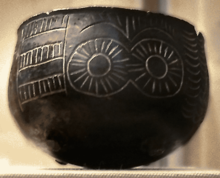Copper Age
prehistoric period (the Copper Age was originally defined as a transition between the Neolithic and the Bronze Age)
The Copper Age was a time period between the Neolithic and the Bronze Age. It is also named Chalcolithic (Ancient Greek: χαλκός khalkos "copper" + Ancient Greek: λίθος lithos "stone").


In the Bronze Age, people added tin to copper to make bronze, an alloy which is much harder than either tin or copper. During the Copper Age, this fact became known, but was not much used because tin was scarce.[1]
The Vinča culture was the first to develop the knowledge and skills to process copper, i, the late 6th millennium BC.[2]
Edged weapons such as knives, swords, spearheads, and axes were made of copper, as were brooches, pins, belt boxes and vessels for food and drink.[1]
References change
- ↑ 1.0 1.1 Trigger, Bruce C. 1996. A history of archaeological thought. 2nd ed, Cambridge University Press. p226
- ↑ Miljana Radivojević et al.: On the origins of extractive metallurgy: new evidence from Europe. In: Journal of Archaeological Science, Vol 37, Issue 11, 2010, pp 2775-2787 doi:10.1016/j.jas.2010.06.012